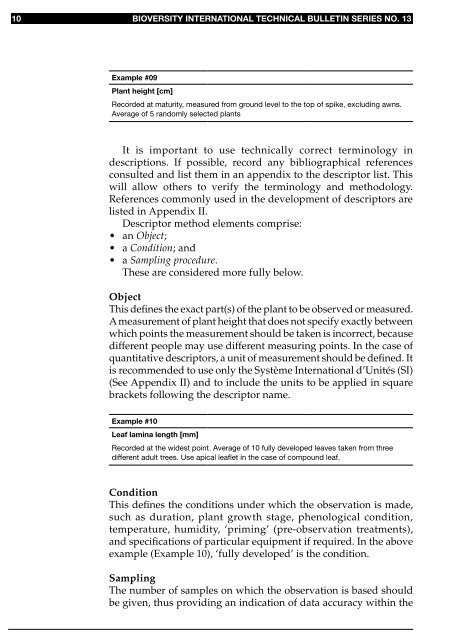Developing crop descriptor lists - Bioversity International
Developing crop descriptor lists - Bioversity International
Developing crop descriptor lists - Bioversity International
Create successful ePaper yourself
Turn your PDF publications into a flip-book with our unique Google optimized e-Paper software.
10 BIOVERSITY INTERNATIONAL TECHNICAL BULLETIN SERIES NO. 13<br />
Example #09<br />
Plant height [cm]<br />
Recorded at maturity, measured from ground level to the top of spike, excluding awns.<br />
Average of 5 randomly selected plants<br />
It is important to use technically correct terminology in<br />
descriptions. If possible, record any bibliographical references<br />
consulted and list them in an appendix to the <strong>descriptor</strong> list. This<br />
will allow others to verify the terminology and methodology.<br />
References commonly used in the development of <strong>descriptor</strong>s are<br />
listed in Appendix II.<br />
Descriptor method elements comprise:<br />
• an Object;<br />
• a Condition; and<br />
• a Sampling procedure.<br />
These are considered more fully below.<br />
Object<br />
This defines the exact part(s) of the plant to be observed or measured.<br />
A measurement of plant height that does not specify exactly between<br />
which points the measurement should be taken is incorrect, because<br />
different people may use different measuring points. In the case of<br />
quantitative <strong>descriptor</strong>s, a unit of measurement should be defined. It<br />
is recommended to use only the Système <strong>International</strong> d’Unités (SI)<br />
(See Appendix II) and to include the units to be applied in square<br />
brackets following the <strong>descriptor</strong> name.<br />
Example #10<br />
Leaf lamina length [mm]<br />
Recorded at the widest point. Average of 10 fully developed leaves taken from three<br />
different adult trees. Use apical leaflet in the case of compound leaf.<br />
Condition<br />
This defines the conditions under which the observation is made,<br />
such as duration, plant growth stage, phenological condition,<br />
temperature, humidity, ‘priming’ (pre-observation treatments),<br />
and specifications of particular equipment if required. In the above<br />
example (Example 10), ‘fully developed’ is the condition.<br />
Sampling<br />
The number of samples on which the observation is based should<br />
be given, thus providing an indication of data accuracy within the

















